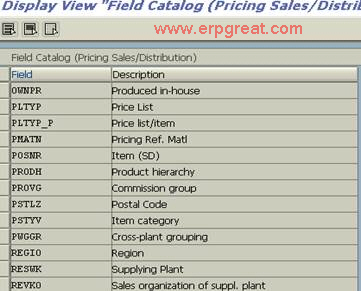Condition technique is used when a complex, ever-changing set of business rules need to be configured as generically as possible in the system. For example, in pricing, each organization has their own set of business rules including base price, margins, discounts, taxes, surcharges, deals/promotions, price lists etc. For a single system to be generic enough to cater to all of these complex needs is a challenge in itself and that is exactly what condition technique tries to solve.
Condition Technique at a Very High Level
There are 7 key components of Condition Technique.
1. Field catalog
2. Condition Table
3. Access Sequence
4. Condition type
5. Pricing procedure
6. Pricing procedure determination
Field Catalog
Field Catalog consists of all the possible set of fields that play a role in determining the business rules. This transaction is Cross-Client. If the business requires that new fields be available in the field catalog, then they need to be added to the structures in either of the .INCLUDE or .APPEND components.
Order Type- AUART Material Group- MATKL
Customer- KUNNR Bill-to party- KUNRE
Material- MATNR

Access Sequence
Access sequence comprises of a sequence of condition tables prioritized in a particular order. An Access Sequence is virtually a sequence in which the condition tables are accessed to determine which parameter to consider. For example, in pricing, if you want the discount per material to over-rule the discount per customer, then you would position the discount per material condition table above the discount per customer table.